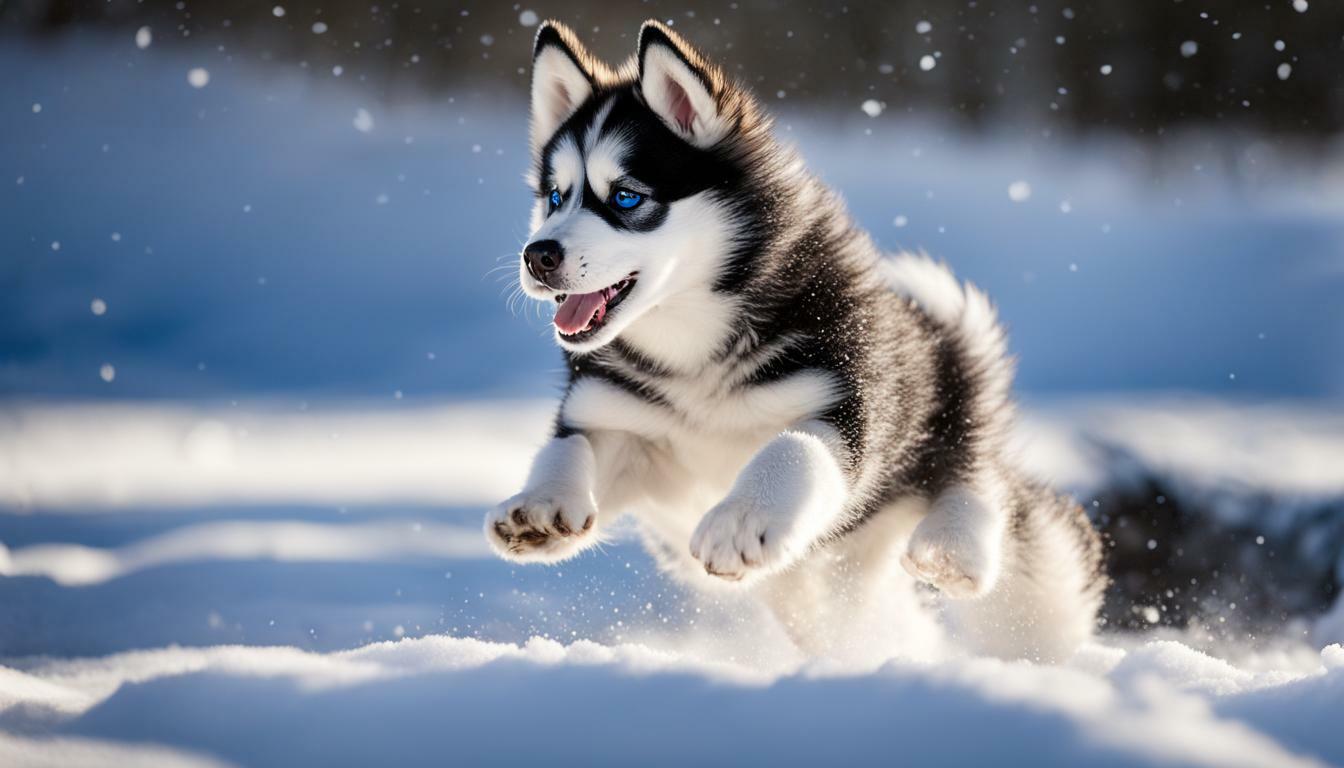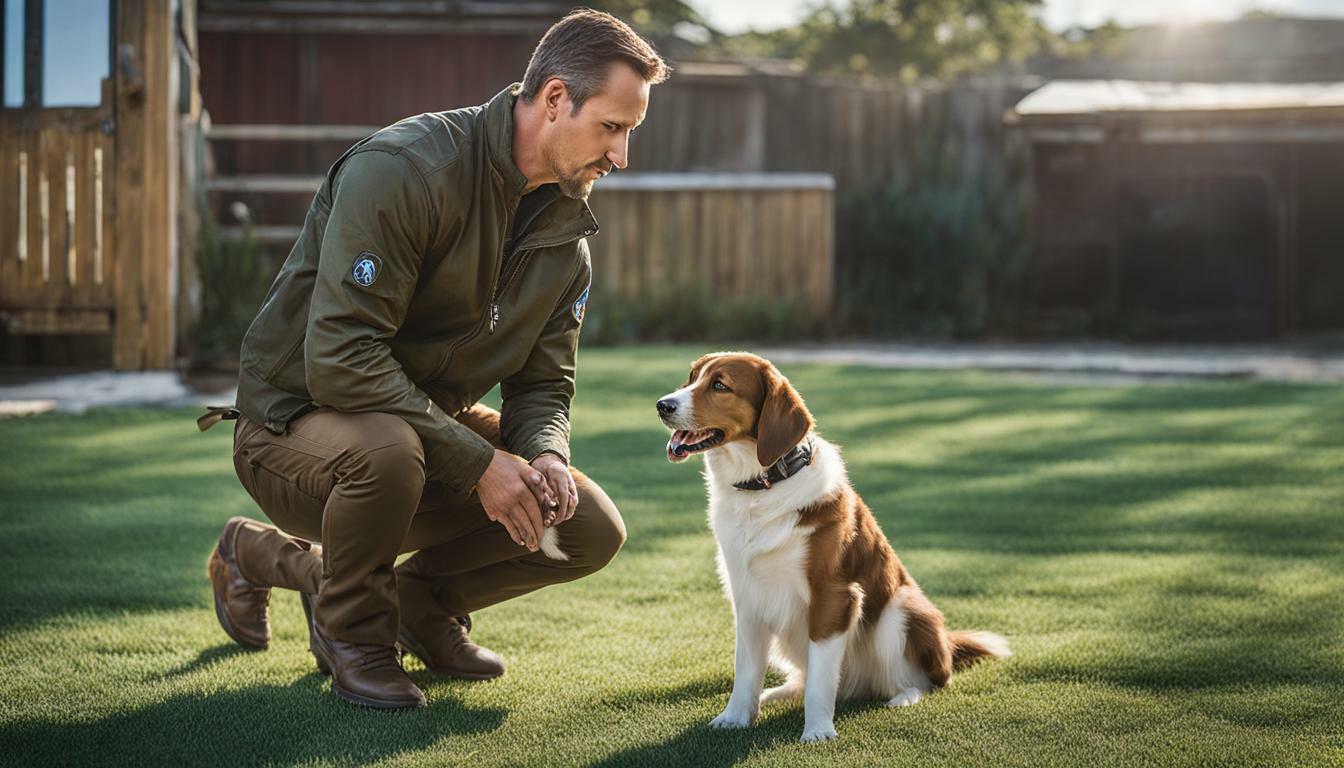Are you considering bringing a Siberian Husky into your home? These majestic dogs are known for their striking beauty, intelligence, and loyalty. However, becoming a Siberian Husky owner requires commitment, patience, and a thorough understanding of the breed’s needs.
In this Siberian Husky ownership guide, we will provide you with a comprehensive overview to ensure that you are fully prepared to welcome a Husky into your home. From essential care tips to training techniques and addressing behavior problems, we will guide you on how to be the best parent to your Husky and build a strong bond with this beautiful breed.
Key Takeaways:
- Becoming a Siberian Husky owner requires commitment, patience, and a thorough understanding of the breed’s needs.
- This guide will provide you with essential care tips, training techniques, and solutions to common Husky behavior problems.
- Proper socialization, exercise, and nutrition are crucial for the physical and mental well-being of your Husky.
- Choosing a reputable breeder and evaluating puppies is critical to find the perfect Husky companion that fits your lifestyle.
- Prioritizing your Husky’s long-term health and wellness requires preventive care and awareness of common health issues in Huskies.
A Siberian Husky is a beautiful and energetic breed known for their striking appearance and friendly disposition. They were originally bred in Northeastern Asia by the Chukchi people as sled dogs, capable of pulling heavy loads through harsh environments.
Today, Siberian Huskies are popular pets but are still used in some parts of the world for sled racing and other working purposes. They have a thick double coat that keeps them warm in cold temperatures and comes in a variety of colors, including black, white, gray, and brown.
One of the most unique characteristics of the Siberian Husky is their blue or multi-colored eyes, which is a result of a genetic trait. However, not all Huskies have blue eyes, and some may have one blue eye and one brown eye.
As an owner, it’s important to understand that Siberian Huskies have specific needs and traits that may not be suitable for everyone. They require regular exercise and mental stimulation to keep them happy and healthy, and they have a high prey drive that can lead to chasing small animals.
Additionally, Huskies are known to be stubborn and independent, which can make training challenging at times. However, with patience and consistent positive reinforcement, they can be trained to be well-behaved and obedient companions.
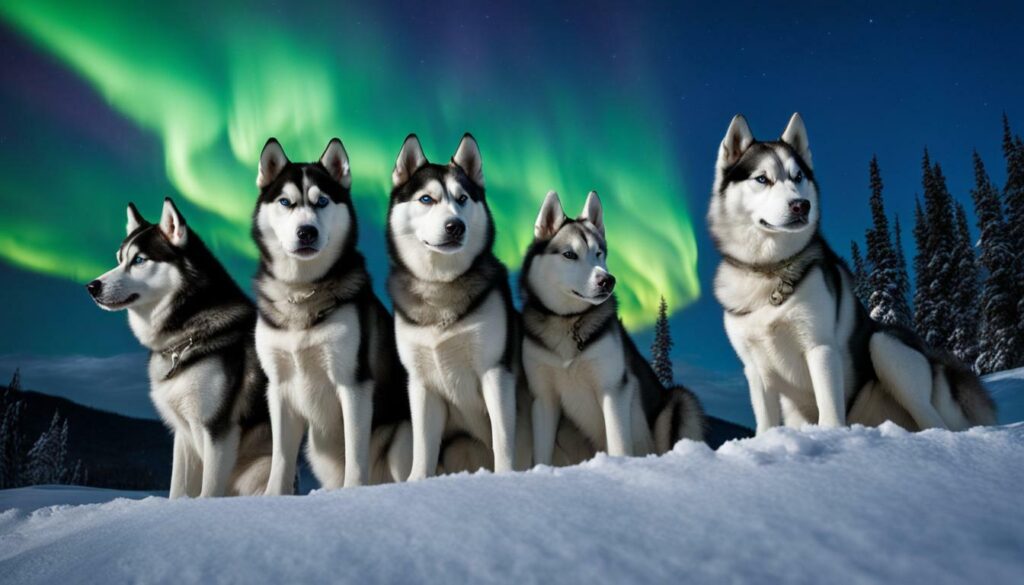
The Siberian Husky breed has a long and fascinating history that dates back to over 3,000 years ago. They were initially bred by the Chukchi people of Northeastern Asia to pull heavy loads through the harsh Arctic environment.
The Chukchi people relied heavily on these dogs for transportation and survival, and they were treated as valuable members of their communities. The breeding of Siberian Huskies was carefully controlled, and the dogs were highly prized for their endurance, strength, and loyalty.
In the early 1900s, Siberian Huskies were brought to Alaska for sled racing competitions, where they quickly gained popularity. Today, they are recognized by the American Kennel Club as a breed in their own right and are a beloved breed around the world.
Traits of the Siberian Husky
Siberian Huskies are known for their friendly and outgoing personalities. They are affectionate with their families and enjoy spending time with them. However, they can be wary of strangers and may require proper socialization from an early age to prevent aggression towards new people.
Huskies have a high prey drive, which can make them unsuitable for households with small animals such as cats, rabbits, or guinea pigs. They are also known for their independence and stubbornness, which can make training a challenge without the proper techniques and patience.
Overall, owning a Siberian Husky can be a rewarding experience for those who are willing to put in the time and effort to properly care for them. In the next section, we will discuss essential care tips to keep your Husky happy and healthy.
Husky Care Tips for a Happy and Healthy Companion
Siberian Huskies are known for their beauty, intelligence, and loyalty. To keep your furry friend happy and healthy, it’s important to provide them with proper care. Here are some essential Husky care tips to ensure your companion leads a fulfilling life:
Husky Diet and Nutrition
Proper nutrition is crucial for your Husky’s health and wellness. Their diet should consist of high-quality protein, fats, and carbohydrates to support their active lifestyle. Experts recommend a high-protein diet, such as raw or grain-free kibble, to keep your Husky’s energy levels up. Along with a balanced diet, fresh water should be readily available at all times.
Grooming a Siberian Husky
Siberian Huskies have a double coat, which means they shed frequently. Regular grooming is essential for keeping their coat healthy and shiny. Brushing your Husky once or twice a week can minimize shedding and prevent matting. Bathing them every three months, or as needed, will help keep their coat clean and smelling fresh. Additionally, keeping their ears and teeth clean is crucial for overall hygiene.
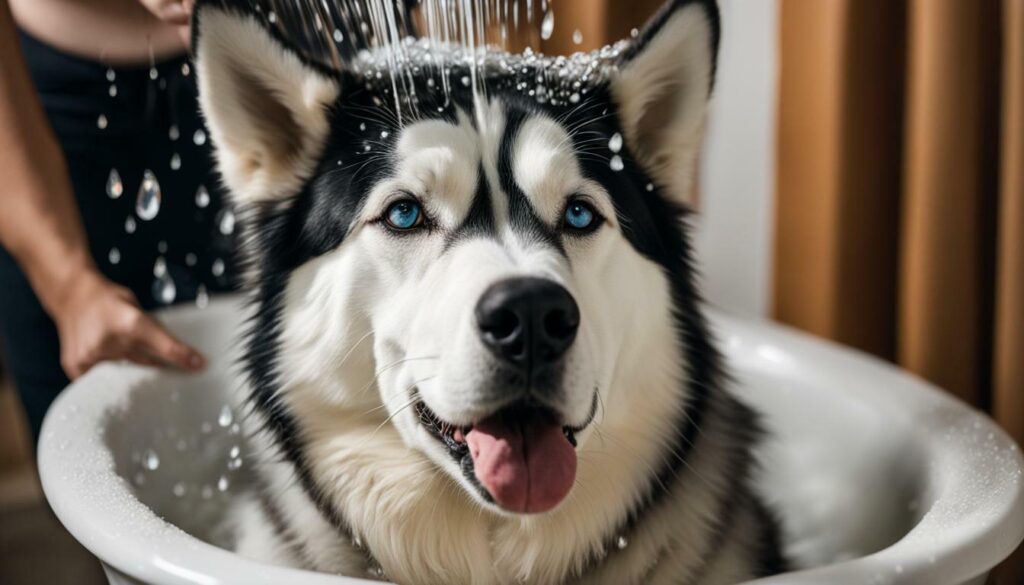
Husky Health and Wellness
Regular veterinary check-ups are vital to maintaining your Husky’s health and well-being. Common health issues in Huskies include hip dysplasia, eye problems, and thyroid issues. Exercise and weight management also play a significant role in your Husky’s health. Daily exercise and a healthy diet can prevent obesity and related health problems.
By providing your Husky with proper care, you can ensure they live a happy, healthy, and fulfilling life.
Training Your Siberian Husky: From Basic Commands to Advanced Techniques
Training your Siberian Husky involves consistent and patient effort to build a well-behaved and obedient dog. Start by establishing yourself as the pack leader and using positive reinforcement techniques to encourage good behavior. Huskies thrive on physical activity and mental stimulation, so incorporate games and exercises into your training routine.
Basic obedience commands such as sit, stay, come, and heel are essential for any dog, and Huskies are no exception. However, training a Husky requires additional effort and attention, as they can be independent and stubborn animals. Be patient and reward good behavior with treats, toys, and praise.
Once your Husky has mastered the basics, you can move on to more advanced training techniques such as agility, tracking, and even search and rescue. These activities will not only improve your dog’s skills, but also strengthen the bond between you and your furry friend.
It’s important to note that Huskies have a high prey drive, so socializing them with other pets and animals from an early age is crucial. Gradually introduce your Husky to other dogs, cats, and small animals, and supervise any interactions closely to prevent any aggressive behavior.
Remember, training your Husky requires consistency, patience, and positive reinforcement. With dedication and effort, you can build a strong and loving relationship with your furry companion.
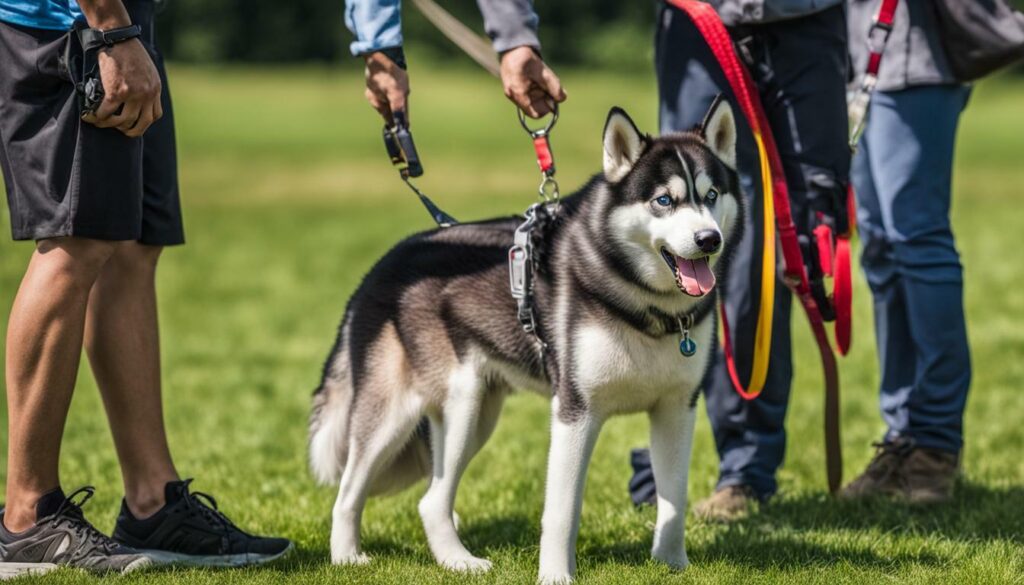
Siberian Huskies are intelligent, independent, and strong-willed dogs that require proper training and attention. However, even with the best care, husky behavior problems can arise, which can be challenging for owners to deal with.
One of the most common issues with Huskies is their tendency to be stubborn and difficult to train. They have a strong prey drive and may chase small animals, including cats and other dogs. They may also resist commands and exhibit destructive behavior, such as chewing or digging.
To address these issues, it’s essential to establish yourself as the pack leader and use positive reinforcement training techniques. Consistent training and socialization from a young age can set your Husky up for success.
Separation anxiety is another common behavior problem in Huskies. These dogs are pack animals that thrive on social interaction, making them prone to anxiety when left alone for extended periods. Symptoms of separation anxiety may include excessive barking, destructive behavior, and even self-injury. To help alleviate separation anxiety, it’s essential to gradually acclimate your Husky to being alone, providing mental stimulation and toys to keep them occupied.
Huskies may also exhibit aggression towards other dogs, particularly of the same sex. This behavior is often due to their strong territorial instincts and dominance. Socializing your Husky with other dogs from a young age can help prevent aggression. If aggression does occur, it’s important to address it immediately and seek the assistance of a professional dog trainer or behaviorist.
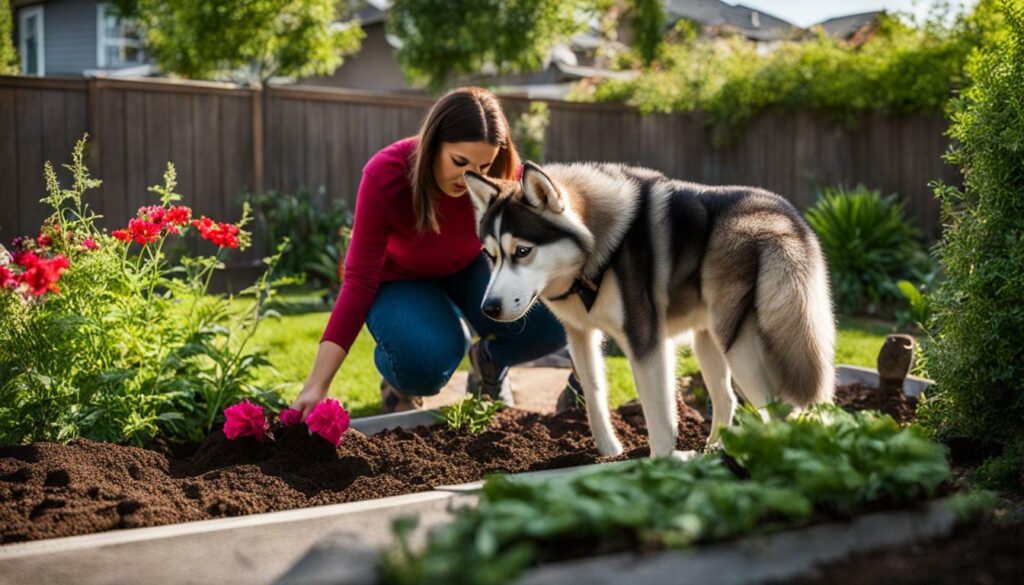
Grooming can also be an issue for Huskies, particularly during shedding season. Their thick double coat requires frequent brushing and grooming to prevent matting and excessive shedding. Neglecting grooming can lead to skin issues and even infections.
Ultimately, understanding and addressing Husky behavior problems requires patience, consistency, and dedication. By establishing yourself as the pack leader, using positive reinforcement training, and providing proper care and attention, you can create a loving and harmonious relationship with your furry friend.
Exercise and Activity: Keeping Your Husky Fit and Content
Siberian Huskies are active and energetic dogs that require ample exercise to maintain their physical and mental well-being. Without sufficient exercise, they can become bored and destructive or develop problematic behaviors. Therefore, it’s crucial to provide them with enough physical and mental stimulation to keep them happy and healthy.
The amount and type of exercise your Husky needs will depend on their age, health, and individual personality. As a general rule, Huskies should get at least one to two hours of exercise every day, including walks, runs, playtime, and other activities. However, some Huskies may need more exercise than others, and it’s essential to pay attention to their signals for fatigue or overexertion.
One of the best ways to exercise your Husky is to take them for a brisk walk or jog. They enjoy long-distance runs and can be excellent jogging companions. Another great option is to take them to a dog park where they can socialize with other dogs and burn off energy together.
Since Huskies have a strong prey drive, they may enjoy playing fetch or exploring nature trails on a leash. You can also provide them with interactive toys, such as puzzle feeders, which can keep their minds stimulated and prevent boredom.
It’s important to note that Huskies do not tolerate hot weather well and should not be exercised in extreme heat. Instead, exercise them during the cooler hours of the early morning or late evening. In contrast, they are well-suited for cold weather and can enjoy playing in the snow or even sled pulling.
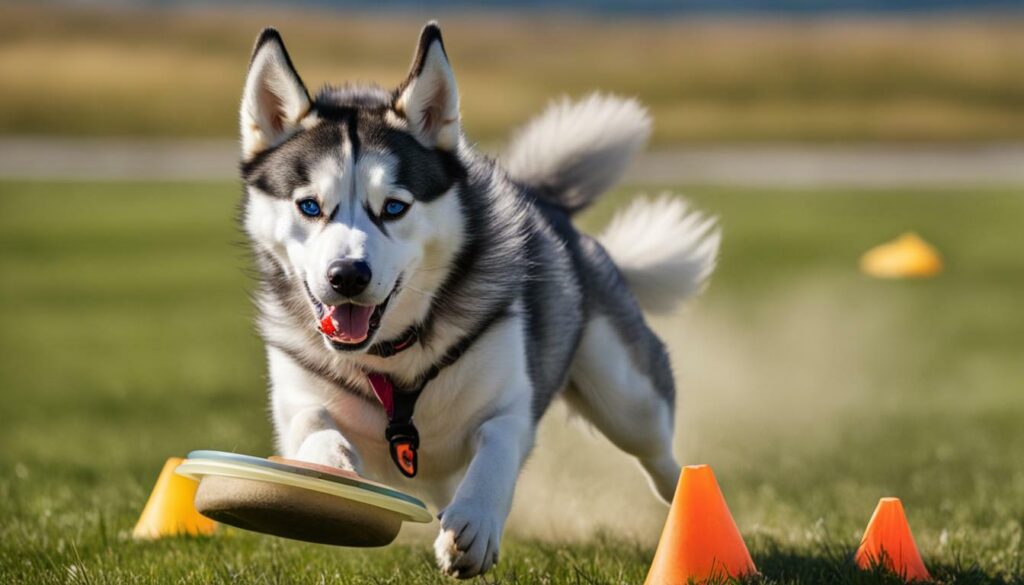
In conclusion, providing your Siberian Husky with ample exercise and stimulating activities is crucial for their physical and mental well-being. Whether it’s going for walks, playing fetch, or exploring nature, regular exercise will help keep your Husky happy, healthy, and content.
Choosing the Perfect Siberian Husky Puppy for Your Family
If you’ve decided that a Siberian Husky is the right dog for you, the next step is to find the perfect puppy to bring into your family. Choosing the right breeder is crucial to ensure that you are adopting a healthy and well-bred Husky. A reputable breeder will help you find a puppy that has been socialized and comes from a healthy bloodline.
When evaluating potential puppies, observe their behavior and temperament. A healthy puppy should be energetic, curious, and confident. They should also be friendly and comfortable around people and other dogs. Avoid puppies that are overly timid or aggressive.
Consider the puppy’s physical attributes as well. Look for a Husky with bright, clear eyes, a shiny coat, and clean ears and teeth. Their body should be in proportion, with good muscle tone and a healthy weight. Check for any signs of illness or injury and ask for any relevant health certifications.
When choosing a Siberian Husky puppy, it’s important to consider your own lifestyle and living situation. Huskies are active dogs that require daily exercise and mental stimulation. If you have a spacious backyard or live in a rural area with ample opportunities for outdoor activity, a Husky may be a great choice. However, if you live in an apartment or have limited space, a Husky may not be the best fit.
Remember, bringing a puppy into your family is a long-term commitment that requires patience, love, and dedication. With the right breeder and careful evaluation of potential puppies, you can find the perfect Siberian Husky companion for your family.
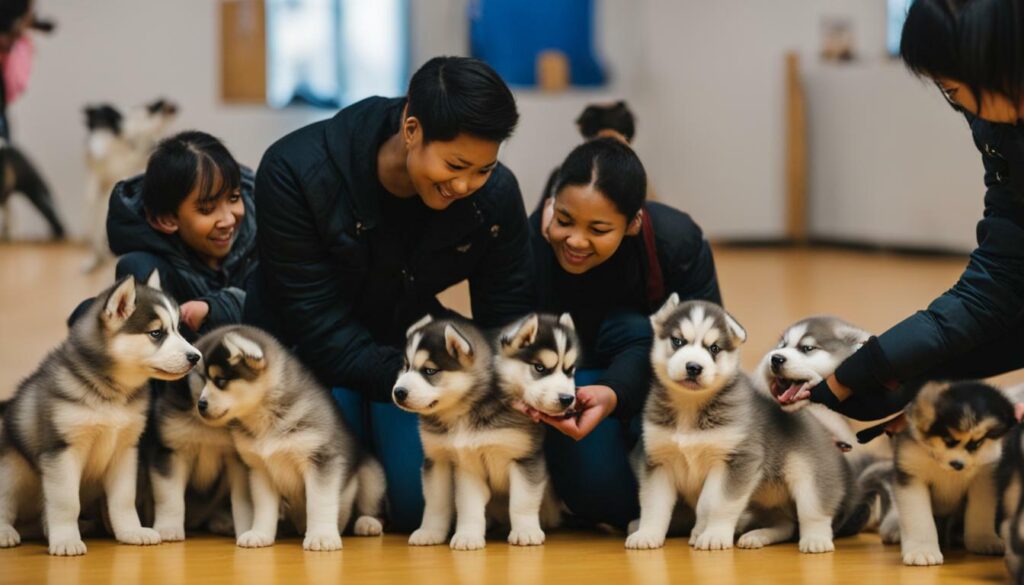
Socialization is critical for your Husky’s development, and it’s essential to start early. Socializing your Husky means exposing them to a variety of people, animals, and environments to help them learn how to behave appropriately in different situations. This will help your dog become a well-adjusted and friendly member of your family and society.
Start socializing your Husky as early as possible, ideally beginning in the first few months of their life. Introduce your puppy to new people, animals, and situations in a controlled and positive environment, such as a puppy class or obedience training.
It’s important to expose your Husky to different types of people, including children, men, women, and individuals from various ethnicities. This can help prevent your dog from developing fear or aggression towards certain groups of people.
In addition to people, your Husky should interact with other dogs and animals to learn appropriate social skills. Always supervise your Husky during these interactions to ensure their safety and avoid any aggressive behavior.
Expose your Husky to different environments, including parks, beaches, and busy streets, to help them feel comfortable and well-adjusted in any situation. Remember, positive reinforcement is key to successful socialization. Reward your Husky with treats, toys, and praise when they exhibit good behavior and react positively to new experiences.
Proper socialization is an ongoing process, and you should continue to expose your Husky to new experiences throughout their life. This will help your dog stay confident, friendly, and well-adjusted.
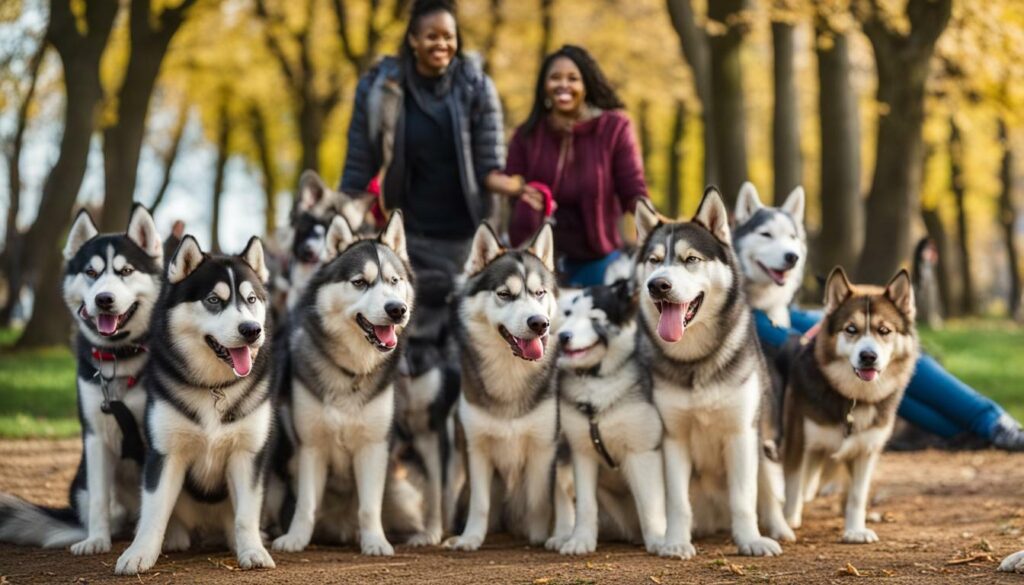
By following these socialization tips, you can help your Husky become a well-adjusted and friendly member of your family and society. Remember that every dog is unique, and it’s essential to tailor your socialization efforts to your Husky’s personality and needs. Socialization is a lifelong process, so keep working on it with patience and dedication, and you’ll have a happy, healthy and well-adjusted Husky companion!
Ensuring Long-Term Health and Wellness for Your Husky
As a responsible Husky owner, ensuring your dog’s long-term health and wellness should be a top priority. Here are some essential tips to maintain your Husky’s overall well-being:
Preventive Care
Regular visits to the vet can help prevent health issues before they become serious. Your Husky should receive vaccinations, parasite prevention medication, and regular check-ups to stay healthy. It’s also vital to keep up with dental care, such as brushing your Husky’s teeth regularly and providing dental chews to reduce tartar build-up.
Common Health Issues in Huskies
Siberian Huskies are prone to specific health issues, such as hip dysplasia, eye problems (such as cataracts), and skin conditions. It’s essential to educate yourself about these issues and understand the signs and symptoms to watch out for. Regular vet check-ups can help catch these issues early and provide appropriate treatment.
Exercise and Nutrition
Adequate exercise and nutrition are critical for your Husky’s long-term health. Siberian Huskies are highly active dogs and require ample exercise to stay in good shape. A balanced diet, with high-quality protein and appropriate fats, is also necessary for your Husky’s overall health and well-being. Consult with your vet to determine the ideal exercise and nutrition regimen for your Husky.
Environmental Factors
Huskies are bred to handle cold weather conditions, but extreme heat can be dangerous for them. Ensure your Husky has access to shade and cool water during hot weather. Additionally, avoid exposing your Husky to extreme cold, as they can develop hypothermia and frostbite. Finally, make sure your home and surroundings are clean and safe for your Husky to avoid exposure to harmful toxins and other environmental hazards.
By prioritizing your Husky’s long-term health and wellness, you can ensure a happy and healthy life for your furry companion.
FAQ
What topics are covered in the Complete Siberian Husky Ownership Guide?
The guide covers a wide range of topics including Husky care tips, training techniques, behavior problems, diet and nutrition, grooming, exercise, choosing a puppy, socialization, and health and wellness.
Why is it important to understand the Siberian Husky breed before getting one?
Understanding the breed’s unique characteristics and needs will help you make an informed decision about whether a Siberian Husky is the right fit for your family and lifestyle.
What care tips are provided in the guide?
The guide offers essential care tips for keeping your Husky happy and healthy, including advice on diet and nutrition, grooming, and overall health and wellness.
What training techniques are recommended for Siberian Huskies?
The guide provides a range of training techniques for Huskies, from basic obedience commands to more advanced methods, helping you build a well-behaved and obedient dog.
How can I address common behavior problems in Huskies?
The guide offers solutions and practical advice for addressing common behavior problems in Huskies, helping you foster a harmonious relationship with your furry friend.
What exercise options are recommended for Huskies?
The guide discusses various exercise options and activities that will keep your Husky physically and mentally stimulated, ensuring they stay fit and content.
How can I choose the perfect Siberian Husky puppy for my family?
The guide provides guidance on finding a reputable breeder, evaluating puppies, and selecting the ideal Husky companion that fits your family and lifestyle.
Why is socializing a Husky important?
The guide emphasizes the importance of early socialization for Huskies and provides effective techniques to help your dog become a well-adjusted and friendly member of society.
What can I do to ensure the long-term health and wellness of my Husky?
The guide offers tips on preventive care, common health issues in Huskies, and maintaining your dog’s overall well-being for a happy and healthy life.
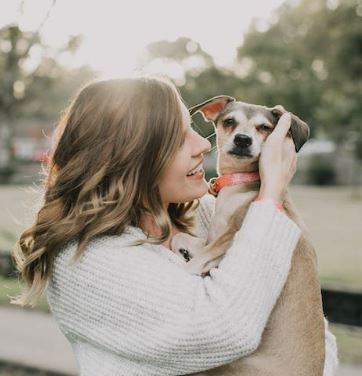
Marissa Delotta, 36, from Dayton, Ohio, is the creative force behind Roverboard.com, a beloved online destination for dog lovers. As a dedicated mom and canine enthusiast, Marissa combines her family experiences with her love for dogs to offer a platform where dog owners can exchange tips, heartwarming stories, and advice. Her website has become a vibrant community for sharing the joys of dog parenting. In her free time, Marissa enjoys exploring dog parks with her family and volunteering at local animal shelters.

